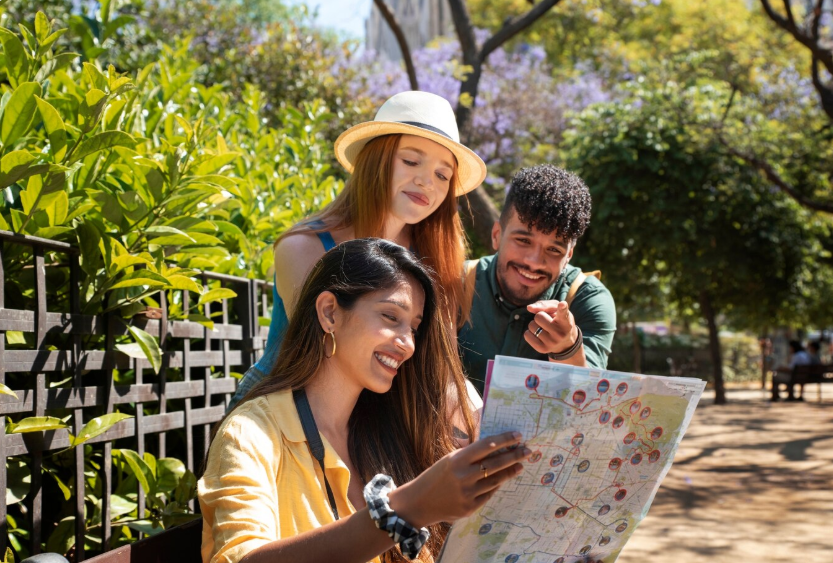
by Dulce Navarro | May 26, 2025 | Business, Culture, Europe, Lifestyle, Traditions, Travel, Work
The Complete Digital Nomad Guide to Living and Working in Europe
As the digital economy continues to evolve, the idea of working remotely while traveling the world has shifted from dream to reality. Europe, with its rich cultural tapestry, modern infrastructure, and variety of visa options, has become a leading destination for digital nomads looking to balance productivity with lifestyle. Whether you’re a freelancer, entrepreneur, or a full-time remote employee, this guide will walk you through everything you need to know about living and working in Europe as a digital nomad.
Why Choose Europe?
Europe offers a unique mix of history, culture, and connectivity. With dozens of countries just a short train or flight away, nomads can enjoy the benefits of diverse experiences while staying within a relatively small geographic region. Moreover, strong internet infrastructure, coworking spaces, and international communities make it easy to stay connected and productive.
Top European Cities for Digital Nomads
1. Lisbon, Portugal
Lisbon is a favorite among digital nomads thanks to its sunny weather, low cost of living, and vibrant tech scene. The city has a well-developed network of coworking spaces, and English is widely spoken.
2. Barcelona, Spain
Barcelona offers a dynamic mix of beach and city life, with a strong digital community and relaxed lifestyle. It’s particularly appealing for creatives and entrepreneurs.
3. Berlin, Germany
Berlin stands out for its affordability (compared to other major cities), rich cultural scene, and support for startups. It’s also home to a large international population and hosts numerous tech events.
4. Tallinn, Estonia
Estonia has pioneered digital governance and was one of the first countries to offer an e-residency program for remote entrepreneurs. Tallinn is charming, tech-forward, and ideal for those seeking a more off-the-beaten-path destination.
5. Split, Croatia
With stunning coastlines, a slower pace of life, and growing digital nomad infrastructure, Split is gaining traction. Croatia now offers a digital nomad visa, making long-term stays possible.
Visas and Residency Options
Several European countries now offer digital nomad or remote work visas, allowing non-EU citizens to live and work legally. Some popular options include:
- Portugal’s D7 Visa – Ideal for remote workers and freelancers with stable passive or active income.
- Croatia’s Digital Nomad Visa – Offers a stay of up to 12 months for non-EU nationals working remotely.
- Estonia’s Digital Nomad Visa – Designed for remote workers employed by foreign companies or self-employed individuals.
- Spain’s Upcoming Digital Nomad Visa – Expected to launch with tax incentives and residency rights for remote workers.
Each visa has its own income requirements, application process, and stay duration. Be sure to research the most up-to-date regulations before applying.
Cost of Living in Europe
Europe offers a wide range of affordability depending on the region. Eastern and Southern Europe tend to be more budget-friendly, while Northern and Western Europe can be expensive. For example:
- Affordable Cities: Sofia (Bulgaria), Budapest (Hungary), Valencia (Spain)
- Moderate Cities: Lisbon (Portugal), Prague (Czech Republic), Athens (Greece)
- Expensive Cities: Paris (France), Amsterdam (Netherlands), Copenhagen (Denmark)
On average, digital nomads can expect to spend between €1,000–€3,000 per month depending on their lifestyle and location.
Connectivity and Workspaces
Most urban areas in Europe offer fast and reliable internet, often exceeding 100 Mbps. Additionally, coworking spaces are common in major cities and even some smaller towns. Platforms like Coworker or Nomad List can help you find the best spaces in your area.
Community and Networking
Being a digital nomad doesn’t mean being alone. Europe has a strong and growing community of like-minded professionals. Joining events, meetups, and coworking hubs can help you build your personal and professional network abroad. Facebook groups, Slack channels, and local Expat groups are also great ways to stay connected.
Managing Finances and Taxes
Banking in Europe is straightforward with online banks like N26, Revolut, and Wise offering low-fee international transfers and multi-currency accounts. However, taxes can be more complex. Depending on your length of stay and legal residence, you may be required to pay taxes locally. It’s highly recommended to consult with a cross-border tax advisor to remain compliant.
Health Insurance and Safety
While Europe is generally safe, having health insurance is essential. Some digital nomad visas require proof of coverage. Consider providers like SafetyWing, Cigna Global, or Allianz International, which offer comprehensive coverage for travelers and expats alike.
Learning New Languages as an Expat: Strategies for Quick Success
Mastering the local language can significantly enhance your experience as a digital nomad in Europe. While many Europeans speak English, especially in urban areas, learning the basics of the local language can open doors culturally and professionally.
Quick Strategies:
- Use Language Apps: Duolingo, Babbel, or Memrise are great for daily practice.
- Practice with Locals: Join language exchanges or use platforms like Tandem to practice with native speakers.
- Take a Local Class: Many cities offer intensive language courses tailored to expats.
- Immerse Yourself: Watch local TV, read signs, and try to use the language daily—even small interactions make a difference.
Language is more than a tool—it’s a gateway to deeper integration and cultural appreciation.
Stay Connected for More Travel and Lifestyle Inspiration
For more insights into travel, culture, and lifestyle tips, follow me on Instagram: @salvadorordorica. If you’re seeking professional translation and localization services to enhance your global ventures, visit The Spanish Group — your trusted partner in bridging cultures worldwide.

by Dulce Navarro | May 23, 2025 | Countries, Culture, Lifestyle, Traditions, Travel, Worldwide
The Power of Cultural Immersion Travel: Experiencing the World Authentically
In today’s interconnected world, travel has become more than a luxury—it’s a doorway to deeper understanding, empathy, and personal transformation. For company directors, global entrepreneurs, and curious professionals, cultural immersion travel presents an unparalleled opportunity to authentically experience life in another part of the world while enriching both personal and business perspectives.
Why Cultural Immersion Travel Matters
Unlike typical tourism, which often revolves around sightseeing and pre-packaged experiences, cultural immersion travel dives beneath the surface. It focuses on living as the locals do, understanding their customs, tasting their everyday cuisine, and participating in their daily routines. This form of travel fosters a greater appreciation for diversity and helps dismantle stereotypes, all while building stronger interpersonal and intercultural communication skills.
Benefits Beyond Sightseeing
- Deeper Cultural Understanding: Immersive travel allows individuals to see the world through a different lens. By living within a community, travelers gain insights into traditions, values, and social structures that define that culture.
- Stronger Emotional Intelligence: Experiencing cultural norms firsthand can challenge assumptions and cultivate patience, adaptability, and open-mindedness—key traits for business and leadership success.
- Professional Edge: Leaders who understand global cultures are better positioned to negotiate, collaborate, and innovate on an international scale.
- Language Skills: Being surrounded by a new language accelerates learning and helps you grasp the nuances of communication far better than any classroom setting.
How to Travel Authentically
To truly immerse yourself in a new culture, it’s important to approach travel with intentionality and openness. Here are some practical ways to ensure your experience is meaningful:
1. Live Like a Local
Skip the hotels and stay in locally owned accommodations or with host families. Explore neighborhoods off the tourist map. Shop at local markets and try regional dishes at family-run eateries.
2. Participate in Cultural Activities
Whether it’s attending a traditional cooking class in Thailand, participating in a village ceremony in Ghana, or helping with olive harvests in Italy, hands-on experiences bring cultural values to life.
3. Learn Basic Language Skills
Even learning a few essential phrases can go a long way in breaking down barriers and showing respect. Locals often appreciate the effort and may open up more readily.
4. Volunteer or Work Abroad
Volunteering or working abroad provides direct engagement with the local community, fostering mutual understanding and growth. It’s also a fantastic way to gain new professional perspectives.
5. Be a Respectful Observer
Observe local customs, dress appropriately, and avoid behaviors that may be considered offensive. Always ask questions with curiosity and humility.
Real Impact of Immersive Travel
One of the most powerful aspects of cultural immersion is the ability to carry those lessons home. Many travelers find themselves transformed—more empathetic, globally conscious, and aware of their role in the broader human experience. These shifts are particularly relevant for leaders who aim to inspire inclusive, culturally sensitive organizations.
Moreover, as sustainability and responsible travel gain momentum, immersion travel supports local economies more directly. Spending money on community-run projects, fair-trade artisans, and neighborhood businesses contributes to ethical tourism and mutual prosperity.
Learning New Languages as an Expat: Strategies for Quick Success
Moving to a new country can be both thrilling and overwhelming. One of the most valuable skills for adapting quickly is learning the local language. Here are a few proven strategies:
- Immerse Yourself Daily: Surround yourself with the language in everyday situations—listen to local radio, watch TV shows, read newspapers, and engage in conversation with locals.
- Use Language Apps: Tools like Duolingo, Babbel, or Memrise are excellent for daily practice and vocabulary building.
- Take Structured Classes: Sign up for language courses designed specifically for expats. Many community centers offer immersive programs at various levels.
- Hire a Language Coach: A private tutor or coach can tailor lessons to your specific needs and help correct pronunciation and grammar in real time.
- Practice Without Fear: Embrace mistakes and speak as much as possible. Locals generally appreciate the effort, and it’s the quickest way to improve.
Language learning is not just about communication—it’s a powerful gateway to understanding the culture, forging authentic connections, and fully enjoying your expat experience.
Stay Connected for More Travel and Lifestyle Inspiration.
For more insights into travel, culture, and lifestyle tips, follow me on @salvadorordorica. If you’re seeking professional translation and localization services to enhance your global ventures, visit The Spanish Group — your trusted partner in bridging cultures worldwide.

by Dulce Navarro | May 21, 2025 | Culture, Languages, Lifestyle, Traditions, Worldwide
Building Inclusive Communities Through Language and Communication
In an increasingly interconnected world, language remains one of the most powerful tools we have for creating inclusive communities. Whether navigating daily life in a new country, growing an international business, or simply connecting with neighbors from different backgrounds, the ability to communicate effectively and respectfully across language barriers is foundational to success and unity.
The Power of Language in Shaping Communities
Language does far more than convey information—it reflects culture, values, and identity. It is the thread that binds communities, fosters trust, and promotes shared understanding. When communication breaks down, misunderstanding and exclusion can take root. But when individuals and organizations make a conscious effort to bridge language gaps, they create opportunities for genuine connection and collective progress.
Consider public services, for example. When municipal announcements, emergency alerts, or healthcare materials are available in multiple languages, they empower non-native speakers to make informed decisions and participate fully in their communities. Similarly, inclusive education environments that embrace multilingualism lead to stronger engagement and better learning outcomes.
Communication as a Tool for Integration
For immigrants and expatriates, communication can be both the biggest challenge and the greatest catalyst for integration. Newcomers who gain proficiency in the local language are not only more likely to find employment, but also to feel a sense of belonging. They can express their needs, build relationships, and contribute meaningfully to the cultural fabric of their new home.
This is why access to affordable, quality language instruction is vital. Communities that invest in ESL (English as a Second Language) programs, cultural orientation workshops, and translation services are investing in their own strength. In doing so, they empower individuals to thrive while fostering mutual respect across cultural lines.
Inclusive Business Practices and Global Impact
Businesses, too, play a central role in building inclusive environments. In the global marketplace, companies that embrace multilingual communication not only stand out—they succeed. Whether interacting with international clients, collaborating with remote teams, or localizing marketing content, effective communication builds trust and reduces costly errors.
More than ever, inclusivity is a business imperative. Brands that translate their websites, provide customer support in multiple languages, and demonstrate cultural awareness are far more likely to attract and retain diverse customers. Employees also benefit: companies that celebrate linguistic diversity are more innovative and foster stronger team dynamics.
Technology and the Future of Language Inclusion
Technology is making it easier than ever to break down language barriers. AI-powered translation tools, multilingual chatbots, and localization software allow businesses and governments to scale their communication efforts with precision. But these tools are most effective when paired with human insight—professional translation services ensure accuracy, nuance, and cultural sensitivity that automated solutions often miss.
As we look to the future, technology will continue to shape how we communicate. However, it’s essential that we approach these advancements thoughtfully, with a commitment to equity and human connection at the core. True inclusion is not just about access to language, but about honoring the people behind each word.
Learning New Languages as an Expat: Strategies for Quick Success
As an expat, adapting to a new linguistic landscape can feel daunting—but it’s also one of the most rewarding parts of the journey. Here are a few practical strategies for achieving language success abroad:
- Immerse Yourself Daily: Surround yourself with the language—watch local TV, listen to music, and read signs and menus. Immersion builds subconscious familiarity.
- Practice with Native Speakers: Language exchanges, conversation groups, and friendly chats with neighbors all help you gain confidence and fluency.
- Use Language Learning Apps: Tools like Duolingo, Babbel, or Rosetta Stone can supplement your learning with structure and gamified lessons.
- Be Patient with Yourself: Mistakes are part of the process. Celebrate progress, no matter how small, and stay consistent.
- Take Formal Classes: If possible, enroll in a structured course. Professional guidance can accelerate your learning and ensure grammatical accuracy.
Ultimately, learning the local language unlocks deeper cultural understanding and empowers you to contribute fully to your new environment. It’s a key step toward building the inclusive, connected world we all aspire to live in.
Stay Connected for More Travel and Lifestyle Inspiration
For more insights into travel, culture, and lifestyle tips, follow me on Instagram: @salvadorordorica. If you’re seeking professional translation and localization services to enhance your global ventures, visit The Spanish Group — your trusted partner in bridging cultures worldwide.

by Dulce Navarro | May 20, 2025 | Countries, Culture, Lifestyle, Travel, Worldwide
Cultural Heritage Preservation: Stories of Traditions That Endure
In our rapidly evolving global landscape, preserving cultural heritage is more than a romantic ideal—it’s a necessity. Culture forms the bedrock of identity, social cohesion, and intergenerational continuity. As cities grow, economies globalize, and digital technologies advance, age-old traditions face unprecedented pressure. And yet, in the midst of change, there are communities and initiatives around the world that continue to breathe life into their cultural legacies.
The Value of Cultural Heritage
Cultural heritage, whether tangible like architecture and artifacts, or intangible like language, music, and rituals, tells the story of humanity. It reflects the values, histories, and wisdom of societies. More than just the past, cultural heritage helps people make sense of the present and provides a compass for future generations. UNESCO has long emphasized the importance of safeguarding heritage as a fundamental human right and a cornerstone of sustainable development.
Stories of Enduring Traditions
Japan’s Washoku Cuisine
In Japan, traditional culinary practices—collectively known as washoku—have not only survived modern fast food culture but have become globally respected for their balance, presentation, and nutritional value. Recognized by UNESCO in 2013, washoku continues to be taught from parents to children, and celebrated through national holidays and communal meals.
Mexico’s Day of the Dead
Despite modernization, Mexico’s Día de los Muertos remains a vibrant expression of cultural identity. This tradition honors deceased loved ones through altars, marigolds, and storytelling. Families across Mexico, regardless of their socioeconomic background, observe the celebration, ensuring that the tradition remains an essential part of the national identity.
India’s Handloom Weaving
In India, the age-old art of handloom weaving—once threatened by industrialization—has seen a revival through artisan cooperatives and government support. Regions like Varanasi and Kanchipuram are once again thriving hubs for traditional textiles. These fabrics, rich in symbolism and technique, continue to be worn proudly on festive and ceremonial occasions.
Scotland’s Gaelic Language Revival
The Gaelic language, once in decline, is being revived through community schooling and media in Scotland. Institutions and local leaders have launched immersion programs and media channels to bring back the language in daily use, helping to safeguard a linguistic heritage central to Scottish identity.
Technology as a Tool for Preservation
Digital archives, virtual museums, and AI-powered language tools are transforming cultural heritage preservation. Platforms such as Google Arts & Culture, for instance, allow global audiences to explore indigenous dances, traditional art, and historical monuments. By integrating technology, communities can document their customs, making them accessible across generations and geographies.
Challenges in Cultural Preservation
Despite global efforts, many traditions face threats—from urban sprawl and climate change to cultural homogenization and loss of native speakers. Migration and displacement can also weaken ties to cultural roots. It’s essential for governments, NGOs, and private sectors to collaborate on policy-making, education, and community engagement that prioritize preservation.
The Role of Businesses in Cultural Heritage
Business leaders and organizations are increasingly recognizing their role in cultural stewardship. Supporting local artisans, sponsoring heritage sites, and integrating cultural elements into branding are all ways companies can contribute. Furthermore, engaging in culturally aware practices enhances brand authenticity and strengthens connections with diverse audiences.
Learning New Languages as an Expat: Strategies for Quick Success
Language is a fundamental part of cultural heritage, and for expatriates, learning the local language can unlock meaningful experiences. Here are a few strategies for success:
- Immerse Yourself: Surround yourself with native speakers through community activities, local markets, and social groups.
- Leverage Technology: Use apps like Duolingo, Babbel, or language podcasts to stay consistent with daily practice.
- Hire a Tutor: One-on-one lessons offer personalized guidance and accountability.
- Be Patient: Language acquisition is a journey—celebrate small wins and stay committed.
By learning the language, expats not only integrate better into their host countries but also become advocates for cultural exchange and preservation.
Stay Connected for More Travel and Lifestyle Inspiration
For more insights into travel, culture, and lifestyle tips, follow me on Instagram @salvadorordorica. If you’re seeking professional translation and localization services to enhance your global ventures, visit The Spanish Group — your trusted partner in bridging cultures worldwide.

by Dulce Navarro | May 20, 2025 | Business, Culture, Lifestyle, Travel, Worldwide
The Role of Multilingualism in Shaping Vibrant Global Cities
In an era of accelerating globalization, cities around the world are transforming into multicultural hubs that thrive on diversity, innovation, and connectivity. At the heart of this transformation lies multilingualism — a powerful tool that not only enhances communication but also fuels economic growth, cultural exchange, and social cohesion. For company directors, entrepreneurs, and global leaders, understanding the role of multilingualism is key to leveraging opportunities and creating inclusive, prosperous urban environments.
Multilingualism as a Pillar of Economic Vitality
Global cities such as New York, London, Dubai, and Singapore have one thing in common: their ability to accommodate and integrate people from a variety of linguistic and cultural backgrounds. Multilingualism contributes directly to economic growth by making cities more attractive to international businesses, investors, and talent. When a city can communicate in multiple languages, it reduces barriers to entry for foreign enterprises and creates more dynamic labor markets.
In sectors like finance, tourism, education, and technology, multilingual professionals are highly valued. They facilitate client relations, improve customer service, and allow companies to tailor their offerings to diverse consumer bases. This capability also enhances export potential and global competitiveness, positioning multilingual cities as vital players on the world stage.
Cultural Enrichment and Identity
Language is more than just a communication tool — it is a carrier of culture, history, and identity. In multilingual cities, residents are exposed to a rich mosaic of traditions, cuisines, music, and perspectives. This diversity not only makes cities more vibrant and interesting but also fosters mutual respect and intercultural dialogue.
Events such as international festivals, multilingual theater productions, and cultural exhibitions become more accessible and meaningful when promoted in various languages. This inclusiveness helps integrate newcomers, promotes social unity, and enriches the collective identity of a city.
Multilingualism in Urban Governance and Public Services
City administrations increasingly recognize the importance of linguistic accessibility in delivering effective governance. From healthcare to legal systems, transportation, and education, providing multilingual support ensures that all residents can access essential services regardless of their language proficiency.
Innovative cities are adopting technologies such as multilingual mobile apps, translation kiosks, and community language support centers to address this need. In doing so, they not only improve public service delivery but also build trust and engagement with all communities.
Challenges and Strategies
Despite the many advantages, managing multilingualism in urban settings comes with challenges. These include ensuring language education equity, avoiding linguistic segregation, and addressing the potential loss of minority languages. City planners, educators, and policymakers must collaborate to implement inclusive language policies and promote lifelong learning opportunities.
Public-private partnerships can play a vital role here. Companies can support multilingual education programs, offer language training for employees, and invest in culturally competent services. For directors and executives, such efforts signal commitment to inclusivity and can significantly enhance a brand’s reputation.
Preparing Businesses for Multilingual Environments
For company directors operating in or expanding into global cities, fostering multilingualism within their organizations is a strategic imperative. This can include hiring diverse talent, offering language learning programs, and ensuring that marketing and communication strategies are culturally and linguistically adapted.
Professional translation and localization services are essential in this context. These services ensure accuracy, cultural relevance, and clarity in all business interactions, from legal documents and websites to product packaging and customer support.
Learning New Languages as an Expat: Strategies for Quick Success
For executives relocating abroad, learning the local language can significantly enhance their experience, effectiveness, and integration. Here are a few practical strategies for success:
- Set realistic goals: Aim for conversational fluency first, focusing on vocabulary and phrases relevant to your daily and professional life.
- Use immersive tools: Language apps, podcasts, and local meet-ups can provide consistent exposure and practice.
- Engage with locals: Practice regularly with native speakers and don’t be afraid to make mistakes — it’s part of the learning process.
- Take formal lessons: Enroll in language courses tailored to professionals or business contexts for structured progress.
- Stay consistent: Language learning is a long-term investment, and daily practice pays off over time.
Multilingualism is not just a benefit — it’s a necessity in today’s interconnected urban world. By embracing language diversity, we open the door to more inclusive, innovative, and prosperous cities for all.
Stay Connected for More Travel and Lifestyle Inspiration.
For more insights into travel, culture, and lifestyle tips, follow me on Instagram @salvadorordorica.
If you’re seeking professional translation and localization services to enhance your global ventures, visit The Spanish Group — your trusted partner in bridging cultures worldwide.

by Dulce Navarro | May 14, 2025 | Company, Countries, Europe, Lifestyle, Travel, Worldwide
Essential Business Travel Tips for Navigating Europe Efficiently
For today’s global executive, Europe represents a dynamic and diverse business environment. Whether you’re attending a trade show in Germany, closing a deal in Paris, or managing operations in Madrid, the ability to navigate Europe efficiently is essential to business success. From managing logistics and cultural expectations to maximizing productivity while abroad, these tips will help make your business trips across Europe smooth, professional, and highly effective.
1. Plan Strategically Based on Your Itinerary
Europe is unique in its compact geography and interconnected transport networks. Before booking anything, map out your trip to minimize backtracking. Consider using regional hubs like Frankfurt, Paris, or Amsterdam as bases, and build your appointments in clusters by region. Multi-city itineraries are often best managed via train or short-haul flights, especially when traveling between major European capitals.
Tools like Google Flights, Trainline, and Rome2Rio can help compare travel times, costs, and convenience. Always leave buffer time between meetings and modes of transport to accommodate delays and local customs.
2. Know Your Travel Documents and Entry Rules
Make sure your passport is valid for at least six months beyond your planned stay. While many European Union countries are part of the Schengen Area, others like the UK, Ireland, or certain Balkan states have their own entry requirements.
If you’re planning repeated travel within the EU, consider applying for a Schengen Visa or using the ETIAS system (starting in 2025) for streamlined entry. Keep digital and printed copies of your ID, insurance, and key documents in a secure cloud storage or encrypted app for easy access.
3. Master Transportation and Regional Mobility
Europe’s high-speed trains, low-cost airlines, and efficient public transport systems make moving between cities and countries relatively seamless. If you’re traveling within cities, ride-share services like Uber and Bolt are common, but be aware that some countries favor local taxi services.
For frequent travelers, investing in a rail pass (such as Eurail or Interrail) or joining airline loyalty programs like Lufthansa’s Miles & More can save both time and money. Always verify whether taxis accept credit cards, and consider downloading public transport apps specific to each city.
4. Pack Smart and Travel Light
When hopping between cities, especially via budget airlines, it’s vital to pack efficiently. Use a carry-on sized suitcase that meets European cabin standards and opt for wrinkle-free, versatile clothing suitable for both meetings and dinners.
Essential items include travel adapters (Type C, E, and F are common), portable chargers, a Wi-Fi hotspot or SIM card, and necessary medications. Organize your belongings with packing cubes and keep business cards, chargers, and toiletries in an easily accessible part of your bag.
5. Embrace Cultural Etiquette and Business Norms
Business culture in Europe varies greatly by country. In Germany and Switzerland, punctuality and formality are expected. In Southern Europe, like Italy or Spain, meetings may start later and be more conversational. Always greet with a firm handshake and learn at least a few local phrases – it goes a long way in establishing rapport.
Business attire should match local expectations: conservative in Northern and Central Europe, slightly more relaxed in Southern Europe. Familiarize yourself with gift-giving customs, email etiquette, and appropriate ways to address contacts based on titles and rank.
6. Book Accommodations with Productivity in Mind
When choosing a hotel or apartment, prioritize proximity to your meeting locations and access to reliable internet. Business hotels often offer quiet workspaces, meeting rooms, and business centers, while luxury serviced apartments provide the comfort of home for extended stays.
Booking platforms like Booking.com and Airbnb for Work allow you to filter properties with desks, strong Wi-Fi, and other business-friendly amenities. Don’t forget to check cancellation policies, especially if your schedule might shift on short notice.
7. Manage Your Schedule and Time Zones
Europe spans several time zones, so it’s important to plan your meetings carefully and confirm appointments using tools like Calendly or Google Calendar with time zone conversions. Set calendar alerts to adjust to local time as soon as you land.
To avoid burnout, factor in rest periods, meals, and travel time. European business hours typically run from 9 AM to 6 PM, with earlier starts in the north and later schedules in the south. Be sure to clarify working hours, especially when scheduling with local teams.
8. Stay Connected and Secure
Roaming charges can add up quickly. Consider getting a prepaid European SIM card or a portable Wi-Fi device for consistent connectivity. Apps like WhatsApp, Microsoft Teams, or Zoom are commonly used for business communication across Europe.
Use a VPN to protect sensitive information when connecting to public Wi-Fi, and set up two-factor authentication on key business apps and email accounts. Staying digitally secure is as essential as staying connected.
9. Maintain Financial Efficiency
Currency conversion fees and international transaction charges can erode your travel budget. Use travel-focused credit cards with no foreign transaction fees, and keep some local currency on hand for small expenses. Be aware that some places may not accept American Express or digital wallets.
Always collect receipts for expense reporting, and consider using apps like Expensify or Concur to streamline your reporting while on the go.
Learning New Languages as an Expat: Strategies for Quick Success
If your business travel turns into a longer stay, learning the local language can greatly enhance your effectiveness and integration. Here are some fast-track strategies for language learning success:
- Immerse Yourself: Listen to local radio, read newspapers, and engage with locals in everyday situations.
- Use Language Learning Apps: Duolingo, Babbel, and Pimsleur are excellent for structured, on-the-go learning.
- Take Local Classes or Hire a Tutor: One-on-one lessons with native speakers can accelerate fluency.
- Practice Daily: Even 10–15 minutes a day can build vocabulary and listening skills quickly.
- Be Patient: Mistakes are part of the process — consistency matters more than perfection.
Mastering a new language isn’t just about communication; it’s about demonstrating respect and commitment to the culture you’re working in. That effort never goes unnoticed.
Stay Connected for More Travel and Lifestyle Inspiration.
For more insights into travel, culture, and lifestyle tips, follow me on @salvadorordorica. If you’re seeking professional translation and localization services to enhance your global ventures, visit The Spanish Group — your trusted partner in bridging cultures worldwide.






